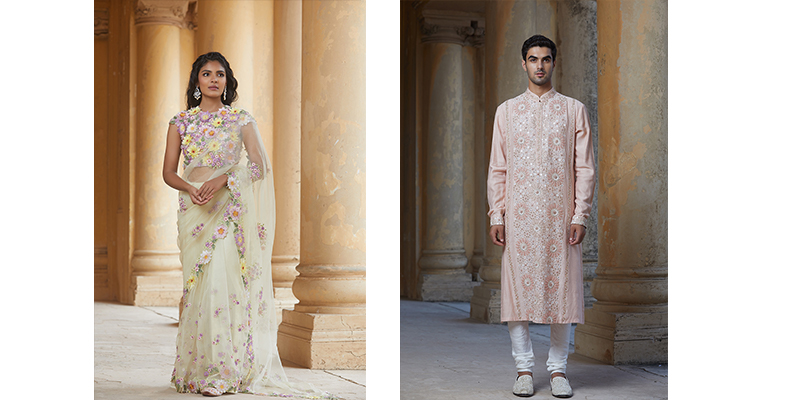Lotus Pond becomes a potent metaphor in Rahul Mishras ICW 2020 line
By Asmita Aggarwal
He is one of the few to be inspired by the simple things of life, which often go unnoticed and he renders these images that his minds eye captures through his expertise– 3 D embroideries. He is a devotee of slower processes and looks at fashion as a means for employment generation, that is the reason why the Aman Nath maintained property, Tijara, a majestic fort served as the perfect backdrop for his ICW 2020 line.
His first introduction to its splendour was when ace lensman Bandeep Singh was shooting his profile picture for Forbes. The ancient courtyards, magnificent ramparts and terraced gardens, left a lingering feeling of wanting to come back here sometime later, and it seemed perfect to shoot his fashion film. Also the property is barely 100 kms from Delhi, making it convenient for 30 people to shoot memories of his line which, this year, is paying tribute to the lotus pond, a metaphor for life and its many vagaries.
Rahul prides himself on being a slow designer one season, one collection, and there is a singular bucket of ideas, he dips into for both Paris and India. Nothing is disjointed, one is the extension of the other. In fact, the concepts are interwoven. I am showing at ICW after my Paris Couture Week line, and I must confess, the focus has always been artwork, and new mediums of doing age-old embroideries, he admits.

The highlight is perfecting techniques and, respecting the innate power of austere design. The theme lotus pond was kind of allegorical, as we all seem to be living in one, and have developed our own survival eco-system, in this pandemic. The lockdown and being at home made me observe human beings and their relationship with nature. I saw the blue skies in Delhi, which I believed was impossible due to the excessive pollution. Dolphins were seen enjoying the oceans and animals roamed freely on roads, cranes were witnessed in Venice. If you want to do something good for the planet, leave it alone and nature will take over and heal, he adds.
The lotus pond is a microcosm in itself, self-sustaining, where the dragonfly comes for nectar, there is fish in the pond, as well as the amphibious frog, and honey bee, it shows when we dont tamper with nature, it is able to retain its beauty and regain vigour. The dirtier it is, the more it flourishes. I went diving in Soneva, Maldives and was mesmerised by the beauty of coral reefs, which give oxygen to us, but most of them have been destroyed. These too became my muse for this years line, he confesses.

Islamic jails, heritage buildings, trails of trees, nature in its uninhibited glory, unlike what humans have done, cut trees and made imposing glass multi-storey buildings making it impossible for us to smell the rain or the wet earth. Couture in India is need-based. It will do exceedingly well. It is sustainable, made by hand, using slow processes, which is what the world needs today. We are not just making just another lehenga, but we are getting a family of craftsmen to participate in this, he adds.
His grandmother used to spin the charkha, and that he believes, it was really the finest couture, unlike fast fashion where we have easily divided people into convenient sizes —small, medium, large and extra large, and removed all needs of making things custom-built. These are all quick fix solutions and dripping with greed. Bespoke offers you happiness, it is tailored just for you. You dont feel the urge to buy immediately, you can mull over and revisit it, and that is what we need today in the fashion space, he says.
Rahul has been inspired by old movies, from how Sharmila Tagore dressed to the simplicity of Madhubala and Meena Kumari. You never needed a movie stylist back then, did you? Things just fell into place, as yesteryear actresses had such innate grace, he adds.
This season, Rahul has indulged in fabric innovations, with his Muga silks that he has developed, silk dupion as well as nifty embroideries. I havent forgotten my 3-D embroideries and sequins, have added just a bit. When I make a line for Paris, I do it like I am a student, just experiment with everything. It is all about shape-shifting, he concludes.

